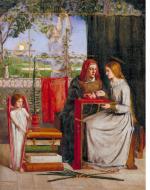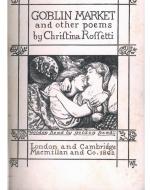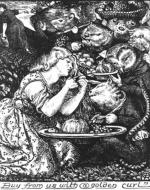Created by Kimberly Pienkawa on Tue, 02/27/2024 - 13:09
Description:
Dante Gabriel Rossetti (1828-1882) is an important English poet, painter, illustrator, and translator. He spearheaded the Pre-Raphaelite Brotherhood in 1848, an arts movement devoted to rich detail, color, and sensuality. The Pre-Raphaelite Brotherhood, known as the PRB, critiqued classical poses and composition associated with the Italian High Renaissance painter Raphael (1483-1520). Early doctrines of the Pre-Raphaelites reveal an emphasis on Nature, authenticity, and Catholic religiosity, associated with English critic John Ruskin. However, Rossetti’s career encompassed many styles of art. Painting and poetry were not separate for him. During the 1830s and 1840s, an Anglo-Catholic religious revival informed Rossetti’s technique. He wrote sonnets to accompany many of his paintings including The Girlhood of Mary Virgin (1848-49). By the 1860s, he favored oil paintings of close-up images of women, such as the Blue Silk Dress (1868) in the style of Italian High Renaissance art. These paintings beamed with a bright and intense color palette. Although Rossetti is best known as a painter and a poet who also created poem and painting pairs, he turned to the lucrative field of book illustration most notably to complete two illustrations for Goblin Market and Other Poems (1862), written by his sister Christina Rossetti. Rossetti's illustrations contrasted with other contemporary caricaturists; he imbued his plates with a seriousness and dignity previously only given painting. As an illustrator, Rossetti applied his attention to detail and admiration for female figures. Outside of his sister's work, he also illustrated the Moxon edition of Tennyson's Poems (1857) and William Allingham's The Music Master (1855). His ornate illustrations engaged with, critiqued, and expanded upon these texts. From illustration to large canvases with accompanying poems, Rossetti emerges as an influential artist known for his sensual work.
George Frederick Watts, Portrait of Dante Gabriel Rossetti, c. 1871, Wikipedia. Dante Gabriel Rossetti was a leading Pre-Raphaelite. Sir John Everett Millais, William Holman Hunt, and Rossetti were known as the Pre-Raphaelite triumvirate. A brief anecdote is that Charles Dickens recoiled at Pre-Raphaelite artist John Everett Millais’s painting entitled Christ in the House of his Parents (1850). Dickens claimed that Mary looked ugly and that the Holy Family’s contortions made them look like unruly alcoholics. Despite this scrutiny and other claims of indulgent sentimentality, the Pre-Raphaelite Brotherhood flourished and embodied Rossetti’s artistic and philosophical principles that art was intimate, personal, and emotional. Rossetti even married one of his muses and models, Elizabeth Siddal.
Dante Gabriel Rossetti, The Girlhood of Mary Virgin, 1848-49, The Victorian Web. This oil painting spotlights Mother Mary as a young woman, learning how to embroider per her mother Anne’s instruction. Rossetti makes this religious subject intimate in modeling the Virgin Mary and St. Anne after Rossetti’s own mother, Frances, and sister Christina (when she was a girl). To Mary’s left, a little angel tends to a towering lily placed in a red pot. The color red emboldens the image and embellishes the embroidered cloth, wings, and fabric that drapes the wall separating the indoor and outdoor spaces. This is a stable and balanced image with pin-straight postures of all the figures (excluding Mary), tiled floors, a stack of books, and symmetry even on the leaves of the lily plant. All in all, the red color and the presence of plants ensures that the painting brims with vitality, but the rigidness of the figures bestows a seriousness and nobility. To accompany the artwork, Rossetti wrote two sonnets, and one further characterizes Mary: “she [Mary] brought devout respect / profound simplicity of intellect / and supreme patience” (ll. 4-6). The poetic lines reinforce devotion, youth, purity, and awe. Rossetti features books, lilies, and cloth in his painting, and in his accompanying poems, he explains that these symbols all refer to Mary’s innocence. He even clarifies the symbolism of the white lily: “so she [Mary] held through her girlhood; as it were / an angel-watered lily, that near God / grows and is quiet” (ll. 9-11).
Rossetti, Dante Gabriel. The Poetical Works. 2vols. [Ed. William Michael Rossetti.] Boston: Little, Brown, 1913. I, 281-82. American printing of British edition published by Roberts Brothers, 1887
Dante Gabriel Rossetti, The Blue Silk Dress, 1868, The Victorian Web. During the 1860s, Rossetti focused on close-up images of women. The deep blue color of the dress here no doubt resonates with the Italian Renaissance style. Although the vibrant color pulls the eye, so do the wrinkles in the fabric, delicately rendered for texture. Rossetti balances out the texture with the smoothness of the woman’s skin, flower petals, and her curled, puffed hair. Moreover, the painting startles with its intimacy, unsurprisingly because of Rossetti’s own romantic relationship with the model, Jane Morris. To Rossetti, Jane embodied beauty and sensuality. The details – the varied textures, color, flowers, and curled hands – all evoke closeness and contemplation. Even as Rossetti dabbled in multiple mediums of painting, illustration, and poetry, and shifted from subjects of religion to personal muses, he depended upon an undeniable intimacy in his work.
Dante Gabriel Rossetti, “Title Page,” Goblin Market and Other Poems, 1862, Mark Samuels Lasner Collection, University of Delaware Library. Although Rossetti’s sensual color palette distinguishes him as an artist, he applied his attention to detail and female figures as an illustrator. He created a title-page vignette and frontispiece for his sister’s renowned poetry collection, Goblin Market and Other Poems (1862). Aligned with his Pre-Raphaelite philosophies, the artwork features erring Laura and obedient Lizzie locked in embrace; the words “golden head by golden head” appear in cursive beneath the two sisters. Rossetti favors geometric and organic shapes: long and flowing hair, a circular moon enfolding the greedy goblins, and floral patterns draped onto a dress. The black-and-white illustration underscores the moralistic threat of the poetic narrative: if Laura indulges in the goblin’s array of fruit, she loses her value in Victorian society. But this design shows Laura and Lizzie embracing, foreshadowing how Lizzie redeems Laura and restores her purity at the poem’s end. The embrace in this vignette forefronts the sisters’ connection.
Dante Gabriel Rossetti, “Buy from Us with a Golden Curl,” from Goblin Market and Other Poems by Christina Rossetti, 1862, The Victorian Web. Dante Gabriel Rossetti illustrated Goblin Market and Other Poems (1862), written by his sister Christina Rossetti. Goblin Market considers the agency and appetite of women through two sisters, good Lizzie and erring Laura, tempted to partake of forbidden fruit offered by goblin men. Victorian society prized modesty and restraint. Lizzie maintains the expectation of decorum: she refuses to cave to the goblin assortment of tantalizing fruit. Laura, on the other hand, is tempted. The goblins leer over Laura’s golden locks and claim this emblem of femininity in exchange for fruit. Dante Gabriel Rossetti freezes this moment: scissors press against Laura’s long, flowing hair, which drapes a plate of pumpkin and pomegranate. The goblins, beastly owls and rodents, menacingly crowd around Laura. The wood engraving brims with claustrophobia; the closeness and clutter of the creatures visualizes the goblins’ crowing and cooing voices in Christina Rossetti’s text. Notably, Lizzie, positioned in the corner of the scene, has short, dark hair, contrasting Laura’s long and shiny golden curls. Rossetti’s illustration reinforces the physical and moral difference between the sisters and features Laura, about to indulge her appetite, compromising her virtue in the eyes of Victorian society. This artwork establishes Rossetti's range, fascination with female figures, and commitment to sensuality.






